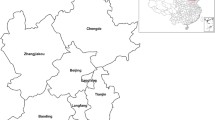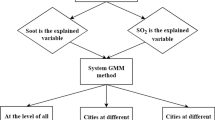Abstract
Based on Panel data collected from 2011 to 2020 targeted to 50 prefecture-level cities in the Yellow River Basin, this paper adopted standard deviation ellipse and spatial Dubin model to explore the nonlinear effects and spatial spillover effects of urbanization on air pollution and ecological resilience in the Yellow River Basin. The results show that the degree of air pollution in the southeast of the Yellow River Basin is higher than that in the northwest of the Yellow River Basin, the distribution range of air pollution is shrinking, the concentration of ecological resilience is enhanced, and the ecological environment is developing for the better. There is a significant U-shaped relationship between urbanization and air pollution in the Yellow River Basin, and an inverted U-shaped relationship between urbanization and ecological resilience. For every 1% increase in urbanization, air pollution decreases by 0.0873%, ecological resilience increases by 0.4046%. For every 1% increase in the square term of urbanization, air pollution increases by 0.2271%, ecological resilience decreases by 0.1789%. The urbanization of the Yellow River Basin has a spatial spillover effect on air pollution and ecological resilience, and urbanization has a significant negative impact on the ecological environment of neighboring cities. The robustness of the above conclusions is verified by introduce an inverse distance weight matrix replacing the spatial weight matrix.






Similar content being viewed by others
Data Availability
Not applicable.
References
Alizadeh H, Sharifi A (2020) Assessing resilience of urban critical infrastructure networks: a case study of Ahvaz, Iran. Sustainability 12(9):3691
Cai D, Wu J, Yang H (2022) Evaluation of farmers’ livelihood ability in Yunnan minority areas based on entropy method. Journal of Kunming University of Science and Technology (Natural Science) 47(3):172–183
Du Y, Wan Q, Liu H, Liu H, Kapsar K, Peng J (2019) How does urbanization influence PM2.5 concentrations? Perspective of spillover effect of multi-dimensional urbanization impact. J Clean Prod 220:974–983
Geng JC, Shen S, Cheng CX (2022) Spatio-temporal evolution and the multi-scale socio-economic influencing mechanism of PM2.5 in the Yellow River Basin during the China’s 13th Five-Year Plan. J Geo-inf Sci 24(6):1163–1175
Han Y, Deng M (2020) Spatio-temporal evolution of eco-efficiency and influencing factors of Central Plains Urban Agglomeration. Acta Ecol Sin 40(14):4774–4784
Jaiswal D, Pandey J (2021) River ecosystem resilience risk index: a tool to quantitatively characterize resilience and critical transitions in human-impacted large rivers. Environ Pollut 268:115771
Jeong, C-H, Wang JM, Hilker N, Debosz J, Sofowote U, Su Y, Noble M, Healy RM, Munoz T, Dabek-Zlotorzynska E, Celo V, White L, Audette C, Herod D, Evans GJ (2019) Temporal and spatial variability of traffic-related PM2.5 sources: comparison of exhaust and non-exhaust emissions. Atmos Environ 198:55–69
Li Heng, Han Yan (2022) Analysis on the spatial-temporal evolution characteristics of PM2.5 and its influencing factors in the Yellow River Basin. World Regional Studies 31(1):130–141
Liu S, Zhu Y, Du K (2017) The impact of industrial agglomeration on industrial pollutant emission: evidence from China under New Normal. Clean Technol Environ Policy 19(9):2327–2334
Liu Junsheng, Li Cui, Tao Jinqing, Ma Yaofeng, Wen Xiaojin (2019a) Spatiotemporal coupling factors and mode of tourism industry, urbanization and ecological environment: a case study of Shaanxi, China. Sustainability 11(18):4923
Liu Z, Xiu C, Song W (2019b) Landscape-based assessment of urban resilience and its evolution: a case study of the central city of Shenyang. Sustainability 11(10):2964
Liu H, Cui W, Zhang M (2022) Exploring the causal relationship between urbanization and air pollution: evidence from China. Sustainable Cities and Society 80:103783
Lu Q, Chang NB, Joyce J, Chen AS, Savic DA, Djordjevic S, Fu GT (2018) Exploring the potential climate change impact on urban growth in London by a cellular automata-based Markov chain model. Comput Environ Urban Syst 68:121–132
Lu B, Ming Q, Liu A, Wei J (2022) Coordination and interaction effect between new urbanization and tourism efficiency. Statistics and Decision (13): 107–112
Pickett STA, Cadenasso ML, Rosi-Marshall EJ, Belt KT, Groffman PM, Grove JM, Irwin EG, Kaushal SS, LaDeau SL, Nilon CH, Swan CM, Warren PS (2017) Dynamic heterogeneity: a framework to promote ecological integration and hypothesis generation in urban systems. Urban Ecosystems 20(1):1–14
Shi G, Lu X, Zhang H, Zheng H, Zhang Z, Chen S, Xing J, Wang S (2022) Air pollutant emissions induced by rural-to-urban migration during China’s urbanization (2005–2015). Environ Sci Ecotechnol 10:100166
Shiboram Banerjee, Arnab Banerjee, Debnath Palit (2021) Ecosystem services and impact of industrial pollution on urban health: evidence from Durgapur, West Bengal India. Environ Monit Assess 193(11):1–18
Wang Baojun, Bin Shi, Inyang Hilary I (2008) GIS-based quantitative analysis of orientation anisotropy of contaminant barrier particles using standard deviational ellipse. Soil and Sediment Contamination: An International Journal 17(4):437–447
Wang S, Gao S, Li S, Feng K (2020) Strategizing the relation between urbanization and air pollution: empirical evidence from global countries. J Clean Prod 243(C):118615
Wang L, Chen T, Wang Y (2022) Spatial spillover of absorptive capacity on provincial innovation output based on spatial econometric model. Sci Technol Manag Res 42(5):18–27
Xia S, Guo S (2021) Ecological efficiency in the Yellow River Basin: spatial-temporal characteristics and influencing factors––based on the panel data of 51 prefecture-level cities. Journal of Statistics 2(6):43–57
Xiao S, Liang Q, Li J (2023) An analysis of the spatial spillover and heterogeneity of urbanization to urban eco-efficiency. Journal of Dalian University of Technology (Social Sciences) (1):1–13
Xiong X, Han Y, Meng X, Liu L, Wang D (2022) Study on development level and spatial-temporal differences of the national ecological civilization construction demonstration areas in the Yellow River Basin. J Environ Eng Technol. https://doi.org/10.12153/j.issn.1674-991X.20220805
Yang H, Liao L, Leng Q (2022) Spatio-temporal characteristics and coupling coordination relationship between urbanization and atmospheric particulate matter pollution in Jiangxi Province. Resources and Environment in the Yangtze Basin 31(4):890–902
Yuan Y, Bai ZK, Zhang J, Xu C (2022) Increasing urban ecological resilience based on ecological security pattern: a case study in a resource-based city. Ecol Eng (175):106486
Zhang X, Du F, Shen X, Zong G (2022) The coupling coordination development and spatial differentiation of economy-energy-ecology-science and technology in the Yellow River Basin. Journal of Safety and Environment: 1–13
Zhao J, Liu Y, Zhu Y, Qin S, Wang Y, Miao C (2020) Spatiotemporal differentiation and influencing factors of the coupling and coordinated development of new urbanization and ecological environment in the Yellow River Basin. Resour Sci 42(1):159–171
Zhao N, Wu X, Li X (2021) Analysis on the spatial correlation of China’s provincial administrative expenditure. Price: Theory Pract (8):168–172
Zhu M, Wang K, Tang H (2022) Study on the spatial spillover effect of green financial development on eco-efficiency: a case study of resource-based cities in the Yellow River Basin. J Financ Dev Res (4):55–62
Funding
This work was supported by the Ningxia Natural Science Foundation under Grant no. 2021AAC03223, the National Natural Science Foundation of China under Grant no. 11761002, FirstClass Disciplines Foundation of Ningxia under Grant NXYLXK2017B09, Western light project of Chinese Academy of Sciences: Application of big data analysis technology in air pollution assessment.
Author information
Authors and Affiliations
Contributions
Funding acquisition, W.D.; investigation, W.D.; methodology, J.L.; resources, J.L.; supervision, J.L.; visualization, W.D. Data availability, J.L. All authors read and approved the final manuscript.
Corresponding author
Ethics declarations
Conflicts of interest
The authors declare no conflict of interest.
Institutional review board statement
Not applicable.
Informed consent statement
Not applicable.
Additional information
Responsible Editor: Marcus Schulz
Publisher's Note
Springer Nature remains neutral with regard to jurisdictional claims in published maps and institutional affiliations.
Rights and permissions
Springer Nature or its licensor (e.g. a society or other partner) holds exclusive rights to this article under a publishing agreement with the author(s) or other rightsholder(s); author self-archiving of the accepted manuscript version of this article is solely governed by the terms of such publishing agreement and applicable law.
About this article
Cite this article
Ding, W., Liu, J. Nonlinear and spatial spillover effects of urbanization on air pollution and ecological resilience in the Yellow River Basin. Environ Sci Pollut Res 30, 43229–43244 (2023). https://doi.org/10.1007/s11356-023-25193-4
Received:
Accepted:
Published:
Issue Date:
DOI: https://doi.org/10.1007/s11356-023-25193-4




